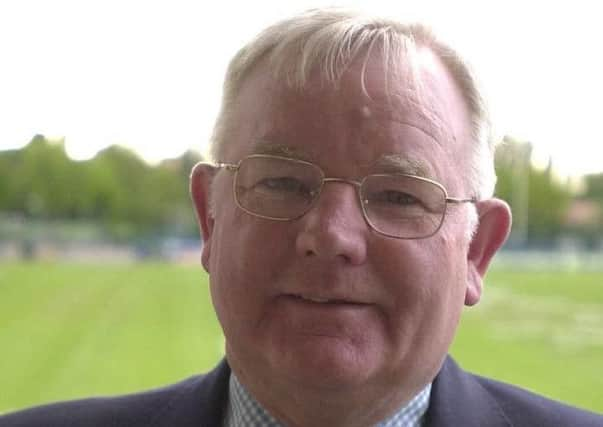Obituary: Tom Howie, businessman who made big impact on the rugby field


Tom Howie, who has died, aged 80, was small in stature, but a veritable giant in the fields of business and rugby, where he was one of the most influential administrators in the history of the game in Glasgow and the West of Scotland.
He was Howie of Dunlop, during the years when he followed his father at the helm of that long-established and important Ayrshire institution. His path was set almost from birth: Dunlop Primary School, then Glasgow Academy. On leaving, he spent two years at the Scottish Agricultural College, learning the basics of the industry he would enter, before National Service with the 16/5 Queen’s Royal Lancers sharpened his leadership skills, before, in 1960, he began to learn the ropes in the family business.
Advertisement
Hide AdAdvertisement
Hide AdHe began in the grain side of the company, before flourishing when he established Lainshaw Farm Eggs, building this firm up to be one of the largest egg-producing companies in Scotland. This saw him become involved in the wider egg industry, as Chairman of the British Egg Industry Council and in Poultry Europe, a commitment which saw him become a familiar figure in the EU’s corridors of agricultural power.
Tom was one of the instigators in the stamping of the wee lion on eggs to confirm freshness, while he vigorously fought the corner of the British egg producers in the wake of Edwina Currie’s legendary Salmonella scare.
He was national convener of NFU Scotland between 1986 and 1990, while he also served on the Scottish Agricultural Wages Board, and his commitment to the sector saw him made a Fellow of the Royal Agricultural Society.
Among the many sectors of the Howie business was the fencing department – one of the largest companies in this field in Scotland, and Tom helped oversee some massive projects, such as the erection of the boundary fence around HMS Clyde – the Faslane naval base.
He also ran Kyle Foods, a pioneering supplier of frozen foods, which was the start-up firm for what is now Iceland.
For relaxation, Tom turned to rugby. He hooked for the XV at Glasgow Academy, before having a lengthy spell in the Kilmarnock Rugby Club XV. However, his lasting impact there was in the committee room. He was involved in the establishment and development of the Bellsland ground and in Kilmarnock’s rise from relative obscurity to becoming one of Scotland’s leading clubs.
He played a key role in the establishment of Kilmarnock-Ayrshire, which saw local junior clubs send their brightest players, such as Dalry HSFP full-back Niven Rose or Ardrossan Academicals stand-off Bryan Gossman, to Bellsland, where they were better able to showcase their talents.
Rose won Scotland B honours, Gossman was capped, as was another he helped attract to Bellsland, Bill Cuthbertson. Tom was a visionary, he put forward the notion of Ayr and Kilmarnock merging to form an Ayrshire super club, but this was a step too far in theat notoriously clannish county. Howevder, the day before he died, Tom saw Ayrshire Bulls, a concept not too far from that he espoused, established.
Advertisement
Hide AdAdvertisement
Hide AdHe went back to his Alma Mater, as a governor of Glasgow Academy, where he helped push through the successful merger with Westbourne School for Girls and, after serving on the committee of Glasgow Academicals, he joined Brian Simmers in the revolutionary move to amalgamate Accies and GHK into Glasgow Hawks.
He was president of Hawks and right up to his death, although no longer actively involved, was a stalwart supporter of the club, and always sought out before games by visiting club officials, keen to avail themselves of his sage advice on rugby matters.
Tom had been Chairman of the Ayrshire selection committee, before taking on the same role with the old Glasgow District, where, as team manager of the Glasgow XV, he worked alongside such great coaches as Bill Dickinson and Richie Dixon.
Away from rugby, he relaxed on the links at Royal Troon, where he was a life member. His other sporting pursuits were angling – he was a leading light in Stewarton Anglish Club – and curling, where he played at Greenacres, home club of his cousin, Olympic gold medal-winning skip Rhona Howie (Martin).
As the leading family in the Dunlop district, the Howies have always been obliged to give a lead in community matters and Tom was no different. He was a keen Burnsian at Lugton Burns Club, he chaired Dunlop Community Council, where he led the fight to keep Dunlop Primary open. He helped establish the Mill Park community facilityin Dunlop, chaired Stewarton and Dunlop Agricultural Society, and gifted some land for the establishment of 36 allotments in Stewarton.
Add his leadership of the establishment of the VE-Day 50th anniversary bonfire, and his being one of the runners who carried the Olympic flame in 2012 and it is clear that Tom Howie did his civic duty
All the while, the great woman behind this great man, Aileen, to whom he was married for 51 years, offered support and firm management. Aileen and the family, son William and daughters Anne, Fiona and Alison, who survive him with his five grandchildren, will be in the front pew at Tom’s beloved Dunlop Kirk for his funeral service on Monday. They will not be alone, given the huge effect Tom Howie had on Dunlop, Ayrshire and West of Scotland rugby during his life.
MATTHEW VALLANCE